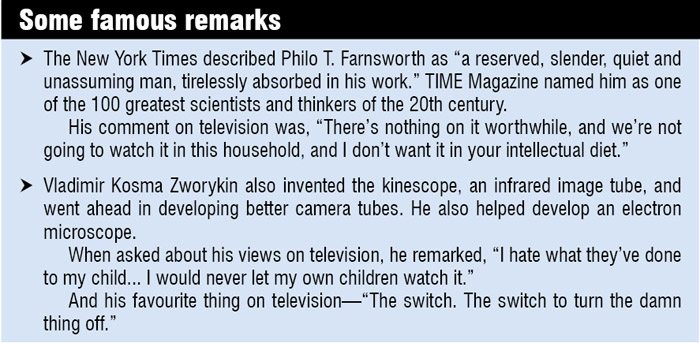The first few trials resulted in very little, except for an electronic interference on the cathode ray tube. Not to be the least discouraged, he improved continuously and on September 7, 1927, he showed his audience the very first electronic transmission of visual intelligence—a black horizontal line on the television receiver built from a chemistry flask.
Philo finally filed for his first television patent on January 7, 1927; the official date of the invention of television.
By now Vladimir K. Zworykin was getting disillusioned at Westinghouse. Sarnoff invited him to be the head of RCA Research Labs at Camden. As he was packing his bags to join RCA, Sarnoff suggested that he might as well visit Farnsworth labs as an engineer for Westinghouse, under the ploy of negotiations for a patent licence. Zworykin prowled around Philo’s lab for three days trying to grab the secrets. When Farnsworth, twenty years his junior, finished the explanation of his image dissector, Zworykin remarked, “This is a beautiful instrument. I wish I’d invented it,” and left. Surprisingly, there was no discussion on patent licence and Philo wondered aloud to his wife if he had shown Zworykin too much.

Sometime later Sarnoff himself landed at Philo’s labs, of course when Philo was out of town. After a breathtaking tour of the labs, he offered to buy the entire enterprise for an unimaginable $100,000. As if to dismiss the entire matter, he added, “There’s nothing here we’ll need.” He left before George Everson, Philo’s brother-in-law, could ask him why he had placed his offer in the first place. When Philo rejected this offer, RCA did the next best thing; dragged him to court on patent rights. He had to spend most of his adult life in a legal fight with one of America’s largest and most powerful corporations. His old school teacher Justin Tolman walked into the court rooms to testify that Philo conceived the idea as a 14-year-old boy. Tolman even produced the original sketch of an electronic tube that Farnsworth had drawn for him in school. The sketch was almost an exact replica of the image dissector Farnsworth had invented.
In April of 1934, the patent office ruled, ‘Priority of invention is awarded to Philo T. Farnsworth.’ RCA appealed and lost. Sarnoff had to eat his words, “The RCA doesn’t pay patent royalties; we collect them.” RCA had to shell out royalty for patent licence for the first time to an independent inventor.
Thousands lined up to see the new electronic marvel at the first public demonstration of Philo’s TV at Philadelphia’s Franklin Institute in 1935. He positioned a camera near the door so that the visitors could see themselves on the nearby ‘receiver’—the bottom of a ten gallon jug. Franklin D. Roosevelt was the first American president on television in April of 1939.
On September 7, 1948, a patent was granted to Louis W. Parker for his ‘intercarrier sound system,’ which is now used in all television receivers.
After the expiry of Philo’s over a hundred patents, RCA started capitalising on them without paying a cent. He had to sell his assets to International Telephones and Telegraph in 1949. He became disillusioned, suffered a nervous breakdown and was bedridden.
When he appeared in 1957 on a popular TV quiz show, ‘I’ve Got a Secret,’ nobody recognised him. He was identified only as ‘Dr X.’ The audience was asked to identify him with some clues. One of the celebrity panelists Bill Cullen asked if he had invented some kind of machine that might be painful when used. The mysterious doctor replied, “Yes, sometimes, it’s most painful.” Revealing his identity as the father of electronic television, the final word on Philo came from the program anchor: “We’d all be out of work if it weren’t for you.”
When man landed on the moon, the entire planet was watching “one small step for mankind” on their television sets; Philo turned to his wife and said, “This has made it all worthwhile.”
The author is a technical training head for Coromandel International Ltd and has numerous books and published articles to his credit










